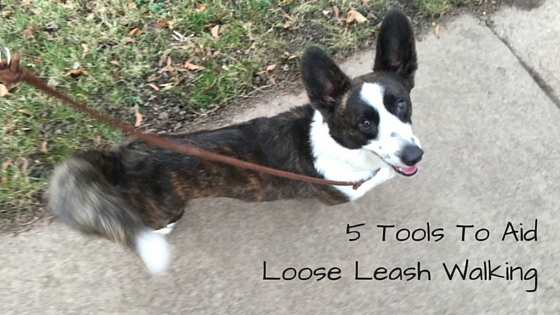5 Tools To Aid Loose Leash Walking

As discussed in a previous article, helping clients teach their dogs to walk nicely on a leash can be a struggle. But there are some tools available that can help your clients manage their dogs and make walks more pleasant while assisting with loose leash walking.
Front Clip Harness
Harnesses are wonderful for keeping pressure off of a dog’s delicate and injury-prone neck area. However, to make a pulling dog easier to walk, you want to make sure the harness clips in the front, at the chest, not at the back. Having a front clip harness can make loose leash walking easier because when the dog pulls, the front clip swings the dog around to face you which keeps them from getting a lot of leverage. The most popular front clip harness is probably the Freedom Harness by 2 Hounds Design.
Waist Leash
It is remarkably frustrating for your clients to have their arms yanked around while walking their dogs. Hand-held leashes can actually hinder loose leash walking a bit because there is no set length for the dog to learn to work within; the leash is perhaps 6′ long when the arm is at the side, but when the dog pulls they can gain another 18-24″ from the arm getting yanked! A good waist leash can provide consistency for the dog to aid in their loose leash walking skills while keeping your clients safe. Not only do their arms not get jerked around because the leash is around their hips, if the dog does lunge they are much less likely to get pulled over because the leash is at their center of gravity. A good waist leash that is safe enough for even the strongest dogs is the Dog-Safe Hands-Free Leash by Blue Dog Training.
Target Cue
A very simple hand targeting cue that has been heavily reinforced can make loose leash walking much more attainable. When your client’s dog starts getting close to the end of the leash, they can cheerfully request a target and the dog will come back and bop their hand. When rewarded for this frequently enough, the dogs will learn it might just be easier to stay closer in case their owner decides to cue them again. Most dogs think hand bopping is great fun!
Large Safely Contained Area Or Long Line
Having access to a fully enclosed field or tennis court has multiple benefits when it comes to loose leash walking. Your clients can allow their dogs off-leash safely to run some of the crazies off before going on a more structured walk. Or they can stroll around the field and reward heavily when their dog comes by them. This creates a dog that loves being around its owner! If the area is not 100% safely contained, a long line can provide the same benefits. Sturdy 50′ lines can be made very inexpensively from items at any large home improvement store. Remember – a 50′ line actually gives the dog 100′ of running room, plenty to allow the dog to zoom off some of that energy.
Clicker And Treats
These are counting as one “tool” because they are a set. Though all the above tools will make loose leash walking more comfortable for your clients, you still want to show them how to use their clickers and treats to train an actual loose leash walking behavior with their dogs, not just manage it. Management is great. Training is better.
What tools have you found that help your clients manage comfortable loose leash walking?
Get Dog Training Business Tips!
Receive valuable dog training business tips and resources every week! Subscribe to The Modern Dog Trainer now by submitting your name and email below.
[mc4wp_form]




